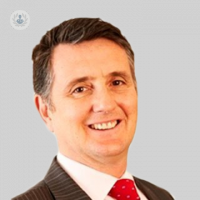How is frozen shoulder treated?
Written by:
Adhesive capsulitis is a condition in which the body forms scar tissue about the shoulder ball and socket joint capsule (glenohumeral joint). This results in a painful, stiff shoulder with limited function.

The condition can either be:
- Primary, whereby there is a progressive loss of motion without any specific trauma or inciting event
- Secondary, where it is acquired as a result of an obvious stimulus e.g. following trauma, surgery or systemic illness.
What are the causes of frozen shoulder?
Adhesive capsulitis can be associated with a number of conditions including prolonged immobilisation of the joint, diabetes, neurological conditions, heart disease and lung disease. Both type 1 and type 2 diabetic patients are at increased risk of developing adhesive capsulitis, and they have worse functional outcomes compared to their non-diabetic counterparts.
The condition is more common in women, in the age range between 40 and 60 years, and there may be a genetic pre-disposition. The condition is usually self-limiting, meaning it will eventually go away by itself, and in many cases frozen shoulder resolves after between one and three years have passed. However, up to 50% of patients may develop longer lasting symptoms.
What are the stages of frozen shoulder?
Traditionally the condition is described in three phases.
- Stage 1: freezing phase
- Stage 2: frozen phase
- Stage 3: thawing phase
In the freezing phase, the shoulder becomes increasingly painful, particularly at night, with progressive restriction in movement.
In the frozen phase, the pain symptoms generally begin to improve but stiffness is maintained.
In the thawing phase, the range of movement is gradually restored to the shoulder.
How is frozen shoulder treated?
The treatment of adhesive capsulitis is dependent on the stage, the timing and the patient. That decision may change during the duration of the disease.
Most clinicians would not recommend physiotherapy during the painful freezing stage. However physiotherapy is very important in phase two, the frozen stage, and three, the thawing phase. Anti-inflammatory medication may improve some symptoms but seldom provides satisfactory relief.
Corticosteroid intra-articular injections are often used, particularly during the painful phase. These injections can significantly reduce pain, although there may be a lag period before range of movement improves.
An injection may be combined with a hydrodilatation technique, whereby a large volume of saline (water) is injected with the steroid. The aim of this technique is to stretch the lining of the shoulder.
Surgery can be performed, but this is usually reserved for cases when there are progressive symptoms which go on for longer than three months, or symptoms which are hard to control or deal with lasting more than six months, and where other treatment options have failed.
Surgical options include an arthroscopic capsular release (otherwise known as keyhole surgery) or a manipulation under anaesthesia.
It should be remembered that whatever treatment is employed, the majority of patients get better, although time scales can be long and variable.
The doctor may also give certain exercises to do once the frozen shoulder is less painful, or refer the patient to a physiotherapist. It should be noted it is not a good idea for the patient to make up their own exercises or strain themselves too much.
With a case of frozen shoulder, it is always important to seek medical opinion.


